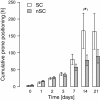Abdominal obesity and prolonged prone positioning increase risk of developing sclerosing cholangitis in critically ill patients with influenza A-associated ARDS
- PMID: 23259907
- PMCID: PMC3543205
- DOI: 10.1186/2047-783X-17-30
Abdominal obesity and prolonged prone positioning increase risk of developing sclerosing cholangitis in critically ill patients with influenza A-associated ARDS
Abstract
Background: Secondary sclerosing cholangitis is a severe disease of the biliary tract. Over the last decade, several cases of sclerosing cholangitis in critically ill patients (SC-CIP) were reported. Reports in the literature so far are characterized by a wide variety of underlying causes of critical illness, thereby hindering a risk-factor analysis. We report on a homogenous cohort of critically ill patients with influenza A (H1N1) pneumonia and severe acute respiratory distress syndrome (ARDS), of whom a subgroup developed sclerosing cholangitis, allowing for probing of risk factors associated with SC-CIP.
Methods: Twenty-one patients (5 female, 16 male, 46.3 ± 10.8 years) with severe ARDS due to H1N1 pneumonia were retrospectively divided into two groups, characterized by the presence (n = 5) and absence of SC-CIP (n = 16). A large array of clinical data, laboratory parameters, and multi-detector computed tomography-derived measures were compared.
Results: Both patient groups showed severe pulmonary impairment. Severity of disease on admission day and during the first 14 days of treatment showed no difference. The patients developing SC-CIP had a higher body mass index (BMI) (37.4 ± 6.0 kg/m(2) vs. 29.3 ± 6.8 kg/m(2); P = 0.029) and a higher volume of intraperitoneal fat (8273 ± 3659 cm(3) vs. 5131 ± 2268 cm(3); P = 0.033) and spent a longer cumulative period in the prone position during the first 14 days (165 ± 117 h vs. 78 ± 61 h; P = 0.038).
Conclusion: Our results suggest that obesity, intraperitoneal fat volume, and a longer cumulative duration spent in the prone position may put patients with ARDS at risk of developing SC-CIP. These results lead us to propose that the prone position should be carefully deployed, particularly in abdominally obese patients, and that frequent checks be made for early hepatic dysfunction.
Figures



References
-
- Gelbmann CM, Rummele P, Wimmer M, Hofstadter F, Gohlmann B, Endlicher E, Kullmann F, Langgartner J, Scholmerich J. Ischemic-like cholangiopathy with secondary sclerosing cholangitis in critically ill patients. Am J Gastroenterol. 2007;102(6):1221–1229. doi: 10.1111/j.1572-0241.2007.01118.x. - DOI - PubMed
-
- Kirchner GI, Scherer MN, Obed A, Ruemmele P, Wiest R, Froh M, Loss M, Schlitt HJ, Scholmerich J, Gelbmann CM. Outcome of patients with ischemic-like cholangiopathy with secondary sclerosing cholangitis after liver transplantation. Scand J Gastroenterol. 2011;46(4):471–478. doi: 10.3109/00365521.2010.537683. - DOI - PubMed
MeSH terms
LinkOut - more resources
Full Text Sources
Medical

